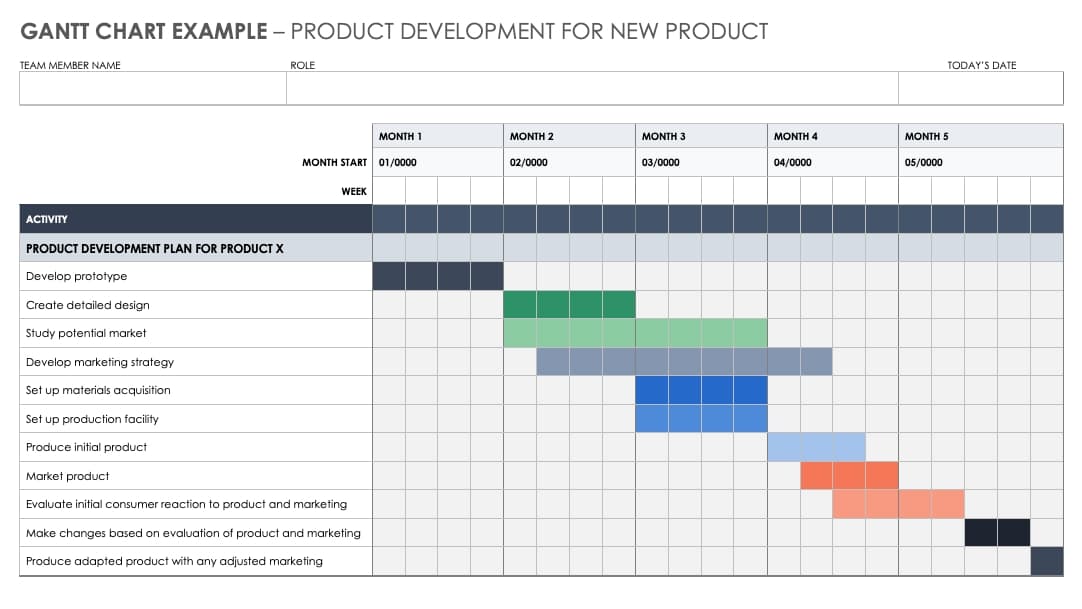Project management is the backbone of successful endeavors, whether they are large-scale construction projects, complex software development, or planning a dream wedding. The ability to plan, track, and execute tasks efficiently and effectively is the difference between a project’s success and failure. In this fast-paced, ever-evolving world, project managers face the formidable challenge of balancing resources, timelines, and deliverables.
However, there exists a tool that has been transforming project management for over a century, offering clarity, organization, and precision like no other: the Gantt chart. Originally developed by Henry L. Gantt in the 1910s, Gantt charts have stood the test of time as an invaluable resource for project managers across various industries.
In this exploration, we will delve into the world of Gantt charts and how they wield their transformative power in the realm of project management. We will dissect their components, understand their history, and uncover the myriad ways in which they revolutionize the project management landscape.
Join us on this journey as we unravel the secrets behind the success of Gantt charts and discover how they enable project managers to visualize success and bring their projects to fruition with precision and confidence. From improved planning to enhanced communication and real-time monitoring, the influence of Gantt charts is profound, making them an indispensable tool for modern project managers.
So, let’s embark on this insightful expedition into the world of Gantt charts and witness firsthand how they have become the cornerstone of successful project management.
Definition and History of Gantt Charts
A Gantt chart is a visual representation of a project’s schedule and tasks over time. It provides a clear, graphical view of a project’s timeline, tasks, dependencies, and progress. Gantt charts are widely used in project management to plan, track, and manage projects effectively.
The Gantt chart is named after its creator, Henry L. Gantt, an American mechanical engineer, and management consultant. Gantt developed this tool in the early 1910s while working on industrial projects, most notably during the construction of the Hoover Dam and the Transcontinental Railroad. His aim was to improve project management by providing a visual representation of tasks and their scheduling.
Before Gantt charts, project management primarily relied on written schedules and tables. Gantt’s innovation was revolutionary because it introduced a simple yet powerful way to visualize project timelines. His charts used horizontal bars to represent tasks and their durations, and these bars were placed along a timeline, allowing project managers to easily grasp the project’s progress and identify potential delays.
Gantt’s charts gained popularity during World War I when they were used for military logistics and production planning. After the war, their application expanded into various industries, including construction, manufacturing, and later, software development. The simplicity and effectiveness of Gantt charts contributed to their widespread adoption in project management.
Key Components of a Gantt Chart
The key components of a Gantt chart are essential elements that make up this visual project management tool. Here’s a breakdown of these components:
- Tasks or Activities: These are the individual work items or activities that need to be completed as part of the project. Each task is represented as a separate bar on the Gantt chart. Tasks are typically listed on the left side of the chart, and each task is associated with a corresponding bar on the timeline.
- Timeline: The horizontal axis of the Gantt chart represents time, which can be divided into days, weeks, months, or other relevant time units. The timeline extends from the project’s start date to its end date. Tasks are plotted along this timeline, showing when they are scheduled to begin and end.
- Dependencies: Dependencies are relationships between tasks that dictate their order or sequence. They indicate which tasks must be completed before others can start. Dependencies are typically represented using arrows or lines connecting the task bars on the Gantt chart. Common dependency types include:
- Finish-to-Start (FS): Task B cannot start until Task A is completed.
- Start-to-Start (SS): Task B can start when Task A starts.
- Finish-to-Finish (FF): Task B can finish when Task A finishes.
- Start-to-Finish (SF): Task B can finish when Task A starts (less common).
- Duration: The length of each task bar on the Gantt chart represents the time required to complete the corresponding task. This duration is usually measured in days, weeks, or months, depending on the project’s scale and timeline.
- Milestones: Milestones are significant project events or achievements marked on the Gantt chart. They are often represented as diamonds or specific symbols. Milestones serve as key reference points to track progress and ensure that important project objectives are met on time.
- Progress or Completion: To track the actual progress of tasks, Gantt charts often include shaded or colored portions within each task bar. These portions indicate how much of the task has been completed over time. This feature helps project managers and team members visualize real-time progress and identify potential delays.
- Resource Allocation: In some advanced Gantt charts, resource allocation may be indicated by assigning specific team members or resources to tasks. This allows project managers to manage resource availability and workload effectively.
- Task IDs or Names: Each task is usually labeled with a unique identifier or name for easy reference. Task names help team members identify their responsibilities and track tasks within the Gantt chart.
- Critical Path: The critical path is a sequence of tasks that determines the shortest possible duration for completing the project. It is often highlighted on the Gantt chart to emphasize tasks that must be closely monitored to prevent project delays.
- Legend and Notes: A Gantt chart may include a legend or notes section that provides additional information or explanations about the chart’s content, such as task codes, colors, or other symbols used for clarity.
These key components collectively make up a Gantt chart, allowing project managers and teams to visualize project schedules, dependencies, and progress, making it an indispensable tool for effective project planning and management.
Advantages of Using Gantt Charts in Project Management
Using Gantt charts in project management offers several advantages that help teams and project managers plan, track, and execute projects more effectively. Here are some of the key advantages of using Gantt charts:
- Visual Clarity: Gantt charts provide a visual representation of the project timeline and tasks. This visual clarity makes it easy for team members and stakeholders to understand the project schedule at a glance, reducing confusion and misunderstandings.
- Task Sequencing: Gantt charts allow project managers to define task dependencies clearly. This sequencing ensures that tasks are completed in the right order, preventing bottlenecks and delays. It helps in creating a logical flow for the project.
- Resource Allocation: Gantt charts can include resource allocation information, enabling project managers to assign team members, equipment, or other resources to specific tasks. This helps in efficient resource management and workload distribution.
- Time Management: Gantt charts provide a clear view of task durations, making it easier to allocate time and set realistic deadlines. This prevents overloading team members and ensures that project timelines are feasible.
- Progress Tracking: Project managers can track the actual progress of tasks against the planned schedule. By comparing planned start and end dates with real-time updates, they can identify delays or ahead-of-schedule tasks and take corrective actions promptly.
- Communication: Gantt charts serve as effective communication tools. They allow project managers to share project plans and updates with team members, stakeholders, and clients in a visually appealing and understandable format.
- Risk Management: Gantt charts help in identifying potential risks and delays early in the project. By visualizing critical paths and dependencies, project managers can proactively address issues, implement contingency plans, and mitigate risks.
- Deadline Management: Gantt charts emphasize project milestones and deadlines. Team members are more likely to stay focused on meeting these milestones when they are clearly displayed on the chart.
- Resource Availability: Gantt charts provide insights into resource availability, making it easier to allocate resources based on their availability and skillsets. This prevents resource conflicts and ensures that the right people are assigned to the right tasks.
- Project Documentation: Gantt charts serve as valuable project documentation. They capture the project’s historical timeline, including task durations, dependencies, and progress, which can be useful for post-project analysis and reporting.
- Flexibility: Gantt charts are flexible and can be updated as the project evolves. Changes to task durations, dependencies, or resource assignments can be easily incorporated, allowing project managers to adapt to unforeseen circumstances.
- Team Accountability: When team members can see their tasks and deadlines on a Gantt chart, they have a clear sense of ownership and accountability for their work. This can enhance team motivation and productivity.
- Client and Stakeholder Engagement: Gantt charts can be shared with clients and stakeholders to keep them informed about project progress and milestones. This transparency can build trust and confidence in the project’s management.
Gantt charts are powerful tools that offer a structured approach to project planning and management. Their visual nature, along with the ability to manage tasks, dependencies, resources, and progress, makes them indispensable for successful project execution and delivery.
Best Practices for Using Gantt Charts
Using Gantt charts effectively requires adhering to best practices to maximize their benefits for project management. Here are some best practices for using Gantt charts:
- Define Clear Objectives: Begin by defining the project’s objectives and scope. Clearly understand what needs to be achieved and the key deliverables before creating the Gantt chart.
- List and Break Down Tasks: List all the tasks and activities required to complete the project. Break them down into smaller, manageable sub-tasks to create a comprehensive task list.
- Set Realistic Timelines: Estimate the duration of each task realistically. Avoid over-optimism or underestimating the time required for tasks. Be conservative to account for potential delays.
- Establish Task Dependencies: Identify and define task dependencies accurately. Use appropriate dependency types (e.g., Finish-to-Start, Start-to-Start) to indicate relationships between tasks.
- Design a Logical Sequence: Organize tasks in a logical sequence on the Gantt chart. Ensure that dependencies and task order make sense for the project’s success.
- Use Milestones: Highlight key project milestones, such as project kickoff, major deliverables, and project completion, as they are essential reference points for tracking progress.
- Assign Responsibilities: Clearly assign tasks to specific team members or resources. Ensure that responsibilities are well-defined, and team members understand their roles.
- Regularly Update and Monitor: Continuously update the Gantt chart as the project progresses. Compare planned timelines with actual progress and adjust as necessary.
- Resource Management: Ensure that resources are allocated appropriately to tasks, considering availability, skillsets, and workload. Avoid overloading team members.
- Use Colors and Codes: Employ color coding and task codes to categorize tasks or indicate different types of work, such as critical tasks or recurring tasks.
- Keep it Simple: While Gantt charts can become complex for large projects, strive for simplicity. Focus on the essential tasks and dependencies to prevent chart clutter.
- Share and Collaborate: Share the Gantt chart with team members, stakeholders, and clients to foster collaboration and ensure everyone is on the same page.
- Regularly Communicate: Hold regular meetings or updates with the project team to discuss progress and address any issues or changes needed in the Gantt chart.
- Anticipate Risks: Use the Gantt chart to identify potential risks and delays. Develop contingency plans and risk mitigation strategies as needed.
- Document Changes: When updates or changes occur, document them in the Gantt chart, including reasons for the changes and their impact on the project schedule.
- Educate Team Members: Ensure that all team members understand how to interpret and use the Gantt chart. Provide training if necessary to improve chart comprehension.
- Use Gantt Chart Software: Utilize project management software or dedicated Gantt chart tools for creating and managing Gantt charts. These tools often provide automation and collaboration features.
- Regularly Review and Revise: Conduct periodic reviews of the Gantt chart to ensure its accuracy and relevance. Revise it as the project evolves and new information becomes available.
By following these best practices, project managers and teams can harness the full potential of Gantt charts as a valuable project management tool, enabling better planning, organization, and execution of projects.
Tips for Effective Gantt Chart Usage
Using Gantt charts effectively requires more than just creating one; it involves thoughtful planning and ongoing management. Here are some tips for effective Gantt chart usage:
| Tips | Action |
| Start with a Clear Plan | Begin by thoroughly understanding the project’s objectives, scope, and deliverables. |
| Break down the project into smaller tasks and sub-tasks to create a comprehensive task list. | |
| Define Task Dependencies | Clearly identify and document task dependencies to ensure that tasks are sequenced correctly. |
| Use appropriate dependency types (Finish-to-Start, Start-to-Start, etc.) to represent task relationships accurately. | |
| Set Realistic Timelines | Estimate task durations realistically, taking into account factors such as resources, skill levels, and potential obstacles. |
| Avoid overly optimistic timelines that could lead to missed deadlines. | |
| Prioritize Tasks | Prioritize tasks based on their importance and impact on the project’s critical path. |
| Focus on completing critical tasks to prevent delays. | |
| Use Milestones Wisely | Highlight key project milestones, such as project kickoff, major deliverables, and project completion. |
| Milestones serve as important reference points for tracking progress. | |
| Regularly Update the Gantt Chart | Continuously update the Gantt chart as the project progresses. |
| Compare planned timelines with actual progress and make adjustments as needed. | |
| Monitor Resource Allocation | Keep an eye on resource allocation to ensure that team members are not overburdened or underutilized. |
| Adjust resource assignments as necessary. | |
| Communicate Effectively | Share the Gantt chart with team members, stakeholders, and clients to ensure everyone is aligned. |
| Use the chart as a visual aid during meetings to discuss progress and potential issues. | |
| Plan for Contingencies | Anticipate potential risks and delays by using the Gantt chart to identify critical paths. |
| Develop contingency plans and risk mitigation strategies in advance. | |
| Document Changes and Revisions | Whenever updates or changes occur, document them in the Gantt chart. |
| Include explanations for changes and their impact on the project schedule. | |
| Educate Team Members | Ensure that team members understand how to read and interpret the Gantt chart. |
| Provide training or guidance if necessary to improve chart comprehension. | |
| Regularly Review and Revise | Conduct periodic reviews of the Gantt chart to ensure it remains accurate and up to date. |
| Revise the chart as needed to reflect the evolving project status. | |
| Use Gantt Chart Software | Consider using project management software or specialized Gantt chart tools for increased automation and collaboration features. |
| Software can simplify the process of creating, updating, and sharing Gantt charts. | |
| Stay Flexible | While Gantt charts provide structure, be prepared to adapt to changing circumstances or new information. |
| Maintain flexibility in your project management approach. | |
| Celebrate Achievements | Use the Gantt chart to acknowledge completed tasks and milestones. |
| Celebrating achievements can boost team morale and motivation. | |
| Seek Feedback | Encourage team members and stakeholders to provide feedback on the Gantt chart’s usability and effectiveness. |
| Use this feedback to make improvements as necessary. |
By following these tips, you can make the most of your Gantt chart as a powerful project management tool, facilitating better planning, organization, and execution of your projects.
Tools and Software for Gantt Chart Creation
There are several tools and software applications available for creating Gantt charts, ranging from simple and free options to more feature-rich and premium solutions. Here’s a list of some popular tools and software for Gantt chart creation:
- Microsoft Excel: Excel is a widely used spreadsheet application that can be used to create basic Gantt charts using built-in features and templates.
- Microsoft Project: Microsoft Project is a dedicated project management software that offers advanced Gantt chart capabilities, including resource allocation, task dependencies, and more.
- Smartsheet: Smartsheet is a versatile online collaboration and project management tool that allows you to create and customize Gantt charts. It offers collaboration features and integration with other software.
- Trello: Trello is a popular task management and collaboration tool that can be extended with plugins like “Placker” to create Gantt charts within the Trello platform.
- Asana: Asana is a project and task management platform that offers a Timeline feature for creating Gantt charts to visualize project schedules.
- Wrike: Wrike is a project management and collaboration platform that provides Gantt chart functionality for project planning and tracking.
- TeamGantt: TeamGantt is an online Gantt chart software designed specifically for project management. It offers easy-to-use tools for creating and sharing Gantt charts.
- Instagantt: Instagantt is a web-based Gantt chart tool that integrates with popular project management platforms like Asana and Trello.
- Monday.com: Monday.com is a work operating system that includes Gantt chart capabilities for project planning, scheduling, and tracking.
- GanttProject: GanttProject is a free, open-source desktop application for creating Gantt charts. It is suitable for smaller projects and provides basic project management features.
- ClickUp: ClickUp is a versatile project management platform that offers Gantt chart views along with task and team management features.
- ProjectLibre: ProjectLibre is an open-source alternative to Microsoft Project, providing Gantt chart functionality for project planning and scheduling.
- Teamwork: Teamwork is a project management and collaboration platform with Gantt chart features for visual project planning.
- Zoho Projects: Zoho Projects is a cloud-based project management tool that offers Gantt chart capabilities, along with other project management features.
- Airtable: Airtable is a flexible collaboration platform that can be used to create Gantt charts using its customizable spreadsheet-database hybrid.
- ClickCharts: ClickCharts is a diagram and flowchart software that includes Gantt chart creation tools for visual project planning.
- MindView: MindView is a mind mapping and project management software that offers Gantt chart views for project planning and tracking.
These tools vary in terms of features, pricing, and complexity, so the choice of the best tool depends on your specific project needs, team size, and budget. Be sure to explore and evaluate different options to find the one that suits your project management requirements the best.
Conclusion
In conclusion, Gantt charts stand as a foundational pillar in the world of project management, offering a transformative approach to planning, executing, and monitoring projects. These versatile tools, pioneered by Henry L. Gantt in the early 20th century, have continued to evolve and remain indispensable for project managers across various industries.
Gantt charts provide a visual framework that fosters clarity and organization in project management. They enable project managers to define tasks, establish dependencies, allocate resources, and set realistic timelines with precision. By doing so, Gantt charts facilitate effective project planning and execution.
The advantages of using Gantt charts are numerous. They provide visual clarity, enhance communication, and enable real-time tracking of project progress. Gantt charts also contribute to better resource management, risk mitigation, and the ability to adapt to changing project dynamics. As a result, they play a pivotal role in visualizing success and ensuring projects are completed on time and within budget.
To make the most of Gantt charts, project managers and teams should follow best practices and tips for effective usage. These practices include defining clear objectives, setting realistic timelines, monitoring progress, and communicating effectively with team members and stakeholders. By doing so, project managers can harness the full potential of Gantt charts as a project management tool.
In today’s fast-paced and complex business environment, Gantt charts continue to evolve alongside technology. With the advent of project management software and online collaboration tools, Gantt charts are more accessible and versatile than ever before. As we look to the future, we can anticipate further advancements in Gantt chart tools and features, ensuring they remain a cornerstone of successful project management.
Gantt charts are more than just a visual representation of project schedules; they are a powerful ally in achieving project success. Embracing their transformative capabilities can lead to better planning, enhanced collaboration, and the realization of project goals. As project managers and teams continue to visualize success through Gantt charts, they will undoubtedly navigate the complex landscape of project management with greater confidence and efficiency.









